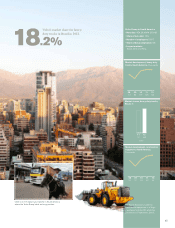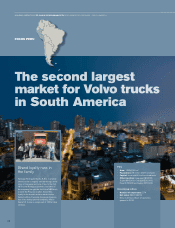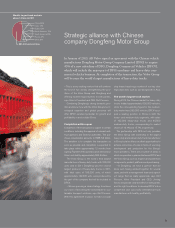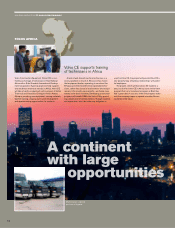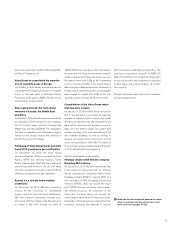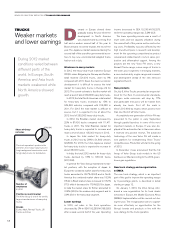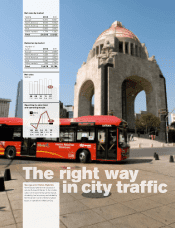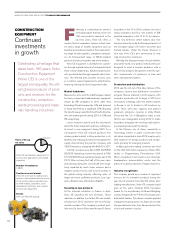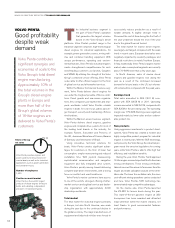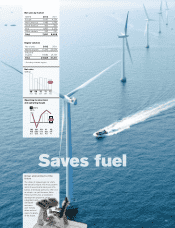Volvo 2012 Annual Report Download - page 59
Download and view the complete annual report
Please find page 59 of the 2012 Volvo annual report below. You can navigate through the pages in the report by either clicking on the pages listed below, or by using the keyword search tool below to find specific information within the annual report.
President EMEA Hub South at Volvo CE, feels that
this offers huge business potential. At the same
time, the real-life situation differs to some degree.
− The focal point for Volvo CE in Africa is the
mining industry. This is where we are largest and
where we are making the most money. There is
no customer in this industry that dares to risk
having machines that are out of action. If you
purchase our machines, you can keep a mine
operating. Chinese companies are capturing a
large number of projects, but they, too, are pur-
chasing their critical equipment from western
companies. At the same time, Chinese excava-
tors have recently started appearing.
In spite of the competition, Johan Haglund
has some winning cards up his sleeve.
− After all, we own a majority of Shandong
Lingong (SDLG). We are Chinese, so to speak.
Historically, Chinese companies have enjoyed a
strong position within wheel loaders. What we
have done now is to establish a network of SDLG
dealers. We also have know-how relating to distri-
bution in Africa, which our Chinese competitors
lack. Taken together, this should be a good argu-
ment for us to sell SDLG in China, to Chinese
companies that are operating in Africa.
Like Jan Vandooren, Johan Haglund is eager
to stress the need for products that are suitable
for the African market. Products of high quality
but with fewer integrated features to enhance
driver comfort, for example, for which customers
in Africa are not prepared to pay.
When Africa is discussed with people in differ-
ent parts of the Volvo Group, Volvo CE is always
mentioned with respect. They have a long history
in Africa, are well positioned and close to their
customers in geographical terms. This is some-
thing of which Hannes Norrgren, Director Mar-
keting & Sales at Volvo Penta with responsibility
for Africa, is keen to take even greater advantage.
− Partnership with Volvo CE is important and it
is often a good match into the bargain. However,
our only chance of quickly increasing our coverage
is through distributors that have the critical mass
to re-invest in their operations, he says.
Engines for gensets constitute Volvo Penta’s
largest business sector in Africa. The manufac-
turing industry is expanding more rapidly than
the infrastructure for electricity distribution.
− A few years ago, our sales of engines for
locally manufactured gensets in South Africa rose
from 50 to 2,000 in the space of one year when
the country found itself in an energy crisis. We are
now relatively stable at approximately 500 engines
a year. There are no alternatives to the diesel
engine when it comes to efficiency and flexibility.
In overall terms, he describes Africa as a pure
aftersales market. It is a question of offering
service and parts in order to increase the num-
ber of engines in imported machines, because
very few machines are actually built in Africa.
Hannes Norrgren therefore faces the same
dilemma as so many others: the potential in
Africa is huge, but we are still not in a position to
take advantage of it.
A joint road ahead
Representatives from the different business
units in the Volvo Group meet regularly at differ-
ent levels to chart their common way forward in
Africa. Coordination is key.
− We already have a strong position in Africa,
but, if we adopt an even more coordinated
approach, we can obtain both improved market
coverage and more effective distribution, as
Peter Karlsten, head of Group Trucks Sales &
Marketing EMEA and a member of the Group’s
executive management team, puts it.
Currently, the truck operations are working
together with a large number of importers in
Africa. However, there are only six in which two
brands share the same importer.
− So there is enormous potential to offer the
same importer much more business with more
brands aimed at different customer segments. This
gives the importer the opportunity to invest more in
his business relationship with us, in the form of an
improved service network, for example. Local con-
ditions naturally influence the best way of working,
says Peter Karlsten and he goes on to underline
Volvo Group in Africa
• Number of employees: 1,120
• Production: Durban and Johannesburg.
• Net sales: SEK 12.168 M (11.371), 4% of
Group sales
• The goal is to increase the truck operation’s
net sales in Africa by 25% by 2015.
Africa
• Area: 30,244,050 km2 (the second largest
continent in the world)
• Population: roughly 1 billion in 55 countries.
• Large countries: Nigeria with 152 million
inhabitants, Egypt (80), Ethiopia (77),
Democratic Republic of the Congo (66)
and South Africa (44).
The focal point for Volvo CE in Africa is the mining
industry. This is where they are largest and it is a profit-
able segment. There is no customer in this industry that
dares to risk having machines that are out of action.
the fact that the Group is currently reviewing the
whole of its strategy for all its truck brands. This is
going to clarify how the different brands and prod-
ucts are going to target different customer seg-
ments. This could also include introducing trucks
from our joint venture with Eicher Motors in India in
the African market.
Engines for diesel-powered gen-
sets constitute Volvo Penta’s
largest business sector in
Africa. Industry is expanding more
rapidly than the infrastructure for electricity
distribution.
55


